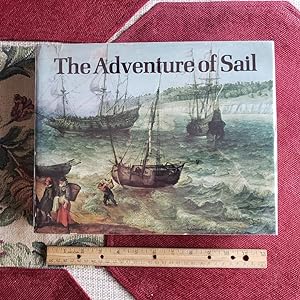Macintyre, Donald; Pigafetta, Francisco Antonio; Bourne, William; Drake, Francis (1 results)
Product Type
- All Product Types
- Books (1)
- Magazines & Periodicals
- Comics
- Sheet Music
- Art, Prints & Posters
- Photographs
- Maps
-
Manuscripts &
Paper Collectibles
Condition
- All Conditions
- New
- Used
Binding
- All Bindings
- Hardcover
- Softcover
Collectible Attributes
- First Edition
- Signed
- Dust Jacket
- Seller-Supplied Images
- Not Printed On Demand
Seller Location
Seller Rating
-
THE ADVENTURE OF SAIL 1520~1914. With An Introduction By by Uffa Fox CBE
Published by NY. 1970. Random House., 1970
Seller: Chris Fessler, Bookseller, Howell, MI, U.S.A.
First Edition
blue embossed oblong hardcover ~ 2º (folio ~ 10"x12"). large ("coffee table" book), international or priority shipping will cost extra. dustwrapper in protective plastic book jacket cover. fine cond. binding square & tight. covers clean. edges clean. contents free of markings. dustwrapper in vg+ cond. minor chipping along the top edge, top of spine, couple of tiny (1cm) tears, not price clipped. nice clean copy. no library markings, store stamps, stickers, bookplates, no names, inking, underlining, remainder markings etc~. first american edition so stated . first printing (NAP). illustrated endpapers. 256p. 44 glossy full color plates. 265 b&w figures. almost every page illustrated. glossary. dictionary of sea terms. types of sailing ship. bibliography. world history. nautical history. maritime history. exploration. cartography. geography. ~ The sailing ship era is part of a continuing adventure, which lives on in the dawning spaceship age; an adventure of the human spirit, discernible not only in great voyages and moments of danger, but also in the discovery of techniques in advances in shipbuilding and navigation. The inspiration of the sailing ship for the artist, manifest in the great marine paintings of four hundred years, is part of the adventure too. So are the excitement and love inspired by the sailing ship in ordinary people, which created the demand for innumerable simple prints of ships throughout the age of sail. Captain Donald Macintyre has written a historical record of four centuries, from the first circumnavigation of the world to the virtual disappearance of the square~rigged ship. This is followed by a selection of contemporary writings of many nations, from 1520 to 1914 ( Francisco Antonio Pigafetta, William Bourne, Sir Francis Drake the Younger, Don Garcia Hurtado de Mendoza, Gerrit de Veer, Willem Cornelison Schouten, Thomas Heywood, A. Richer, George Lord Anson, Louis de Bougainville, Captain James Cook, Horatio Viscount Nelson, Captain Isaac Hull USN, Richard Dana, Captain H. A. Chippendale USN, Basil Lubbock, Basil Greenhill CBE, Joseph Conrad, etc.), each piece showing an important aspect of the age of sail, the whole combining with over three hundred beautiful illustrations to give a comprehensive picture of the sailing ship experience. Captain Macintyre traces the development of sails, rigging and hull design, from the caravel, carrack and galleon to the clipper epoch, when the sailing ship became a thing of visual and functional perfection; and beyond to the autumn of the age of sail, to the great steel~hulled four and five~masted barques and barquentines, which had a strange beauty of their own.' He tells the story of maritime exploration and the establishment of commerce : a story of friendly or hostile competition among nations sharing the common experience of the struggle against the sea. Adventure, in the ordinary sense of dramatic and exciting episodes, fills the history of sail and has received an extraordinary amount of eyewitness documentation. The selection of contemporary documents in this volume unfolds a stirring tale of storms, shipwrecks and fights, of famous ships and the men who sailed in them. It shows, as nothing else can, what life in sailing ships was really like. It relives great moments of discovery or despair, such as the first rounding of Cape Horn, or the last voyage of Willem Barents in his brave and futile search for the Northeast Passage, ennobled by the courage and dignity of a crew lost among ice and polar bears in the dark, dreaded Arctic winter. It evokes the brutality of life at sea, but also its warmer, more humorous side. After the horrors of Anson's voyage it is a relief to read of Bougainville's reception at Tahiti and the meeting of Cook's sailors with the nymphs of Nootka Sound. The odyssey of the human spirit is ever present in The Adventure of Sail, from the perceptive introduction by the famous modern sailing man and boat designer, Uffa Fox, to the highly.


